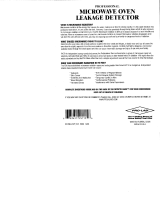
Important Safety Information
!
WARNING
Read the following information to avoid possible exposure to microwave radiation:
The basic design of the Microwave Oven makes it an inherently safe device to both use and service.
However, there are some precautions which should be followed when servicing the microwave to maintain this
safety. These are as follows:
1.
Always operate the unit from an adequately
grounded outlet. Do not operate on a two-wire
extension cord.
2.
Before servicing the unit (if unit is operable) perform
the microwave leakage test.
3.
The oven should never be operated if the door does
not fit properly against the seal, the hinges or hinge
bearings are damaged or broken; the choke is
damaged, (pieces missing, etc.); or any other
visible damage can be noted. Check the choke
area to ensure that this area is clean and free of all
foreign matter.
4.
If the oven operates with the door open and
produces microwave energy, take the following
steps:
A.
Tell the user not to operate the oven.
B.
Contact ACP ComServ
immediately.
5.
Always have the oven disconnected when the outer
case is removed except when making the "live"
tests called for in the Service Manual. Do not
reach into the equipment area while the unit is
energized. Make all connections for the test and
check them for tightness before plugging the cord
into the outlet.
6.
Always ground the capacitors on the magnetron
filter box with an insulated-handle screwdriver
before working in the high voltage area of the
equipment compartment. Some types of failures
will leave a charge in these capacitors and the
discharge could cause a reflex action which could
make you injure yourself.
7.
Always remember that in the area of the
transformer there is HIGH VOLTAGE. When the
unit is operating keep this area clear and free of
anything which could possibly cause an arc or
ground, etc.
8.
Do not for any reason defeat the interlock
switches there is not valid reason for this action
at any time; nor will it be condoned by ACP.
9.
IMPORTANT: Before returning a unit to a
customer, be sure to check for proper switch
interlock action.
10.
The Microwave Oven should never be
operated with any components removed and/or
bypassed or when any of the safety interlocks are
found to be defective, or when any of the seal
surfaces are defective, missing, or damaged.
11.
All microwave ovens meet all requirements
of the radiation control for Health and Safety Act of
1968. Due to measurement uncertainties, the
maximum leakage for the field will be 4mw/cm
2
.
12.
To ensure that the unit does not emit excessive
microwave leakage and to meet the Department
of Health and Human Services guidelines, check
the oven for microwave leakage using amicrowave
oven leakage meter that complies with US
Government CDRH / FDA / DHHS requirements
and or any other local government requirements.
The maximum leakage level allowed by ACP
is 4mw/cm .
13.
If servicer encounters an emission reading over
4mw/cm
2
, the servicer is to cease repair and
contact the ACP ComServ Department
immediately for further direction. ACP
will contact the proper Government
Agency upon verification of the test results.





















